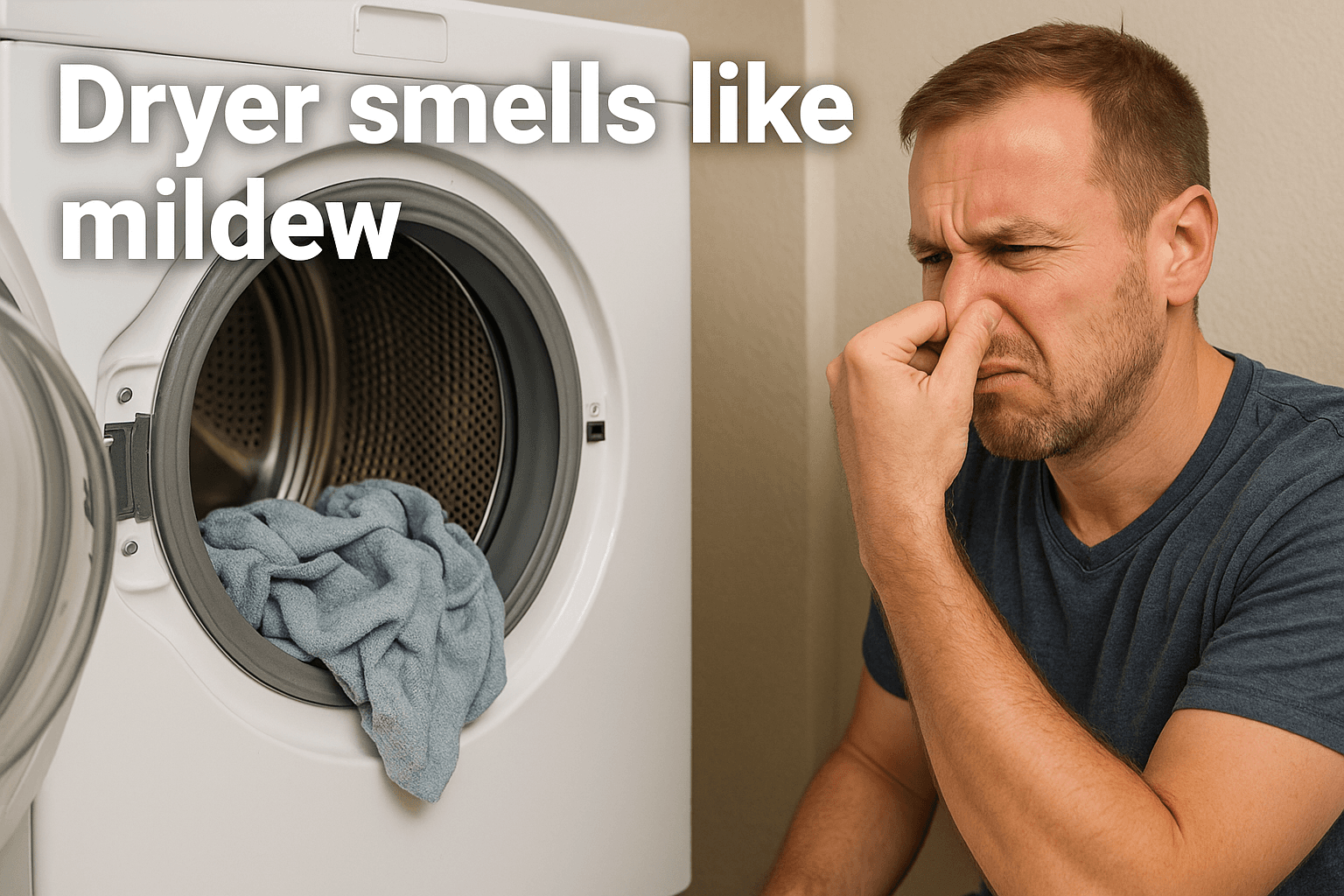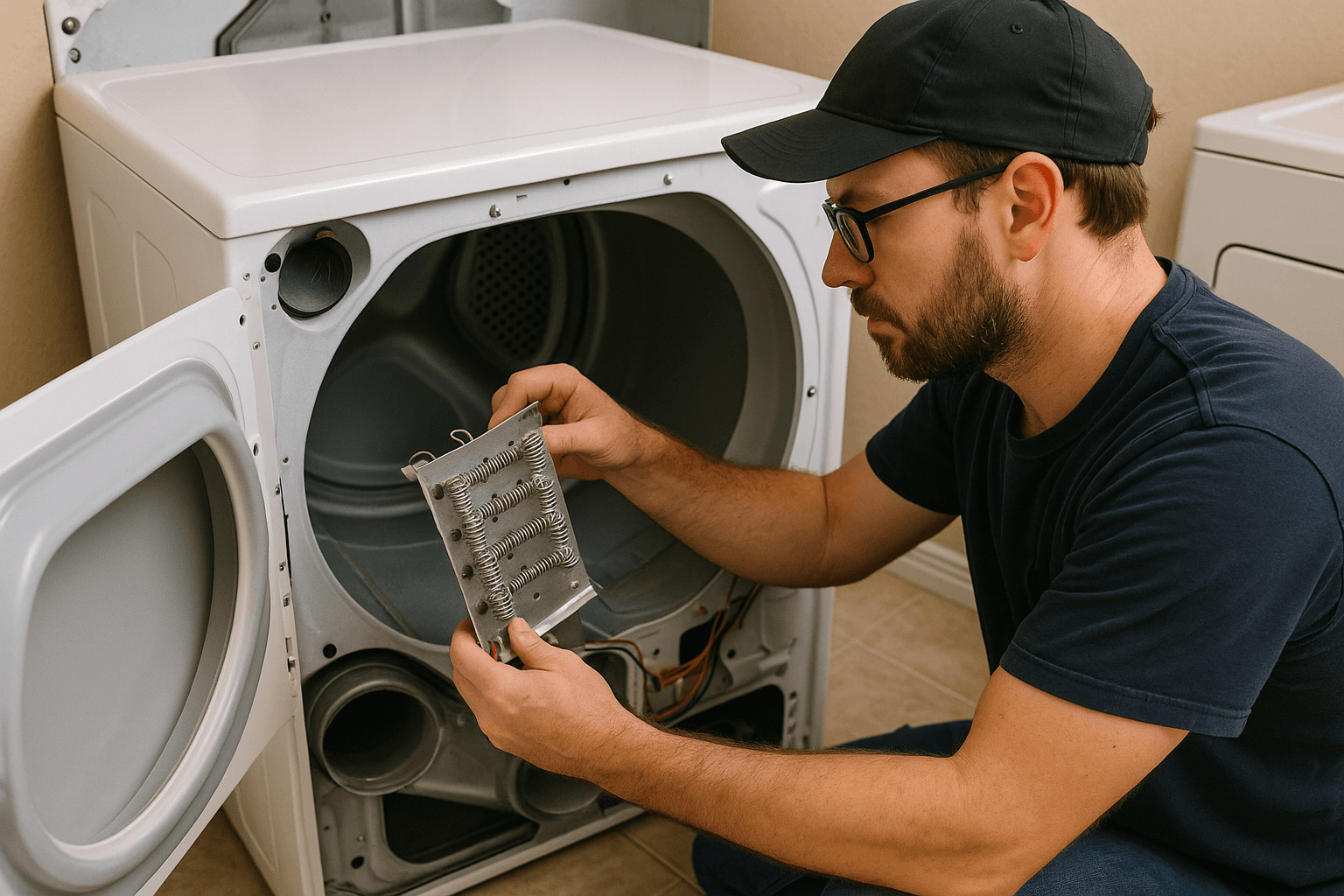Review
7 Common Dryer Problems and How to Fix Them
AZparts Team
Updated on August 1, 2025
8 min read
Dryers are essential for everyday convenience, but like any appliance, they can develop problems over time. From no heat to unusual noises, many common dryer issues have simple causes and even simpler solutions. In this guide, let’s explore seven of the most common dryer issues and how to fix them efficiently. Follow along with AZParts to keep your dryer running smoothly and safely.

1. Common Dryer Issues and How to Fix
Dryers are essential home appliances, but like any machine, they can experience problems over time. Understanding common dryer issues and knowing which parts to replace can help restore performance quickly and safely. Below are typical dryer problems and suggested solutions based on replacing faulty components.
1.1. Dryer Spins but Produces No Heat
If your dryer drum spins but there is no heat, the heating element may have burned out. This component is essential for generating the heat required to dry your clothes. When it fails, the dryer continues to run but cannot dry properly.
In gas dryers, a blown thermal fuse is one of the most common reasons for heat failure. This can happen when lint builds up in the exhaust vent or the lint screen, causing the dryer to overheat and triggering the fuse to shut down the heating function. Be sure to inspect the lint screen and flexible vent hose first, as clogs are a frequent and preventable cause of overheating.
If there are no visible blockages and the dryer still does not heat, other components like the thermal fuse, gas valve coils, or ignition system could be the source. For gas dryers, scheduling a service technician is recommended to ensure a proper diagnosis and repair. If you prefer a hands-on approach, you can follow a step-by-step guide from a trusted gas dryer troubleshooting resource.
To help you find the right solution, AZParts offers several high-quality dryer heating elements and related replacement parts that are tested for performance, durability, and easy installation.
Dryer spin is responsible for producing the heat needed to dry your clothes (Source: AZParts)
1.2. Dryer Won’t Turn On
When a dryer shows no signs of power at all, the most common causes are related to the power supply. A tripped circuit breaker, a loose plug, or a disconnected power cord are often the first things to check. These simple issues can easily prevent the machine from turning on entirely.
While a thermal fuse or door switch can also cause startup problems, they are more likely to stop the drum from spinning even though the unit still has power. A blown thermal fuse acts as a safety device, cutting off operation when the dryer overheats, while a faulty door switch prevents the cycle from starting if the door is not properly closed.
To restore normal operation, replace any defective components after ruling out power supply issues. For a reliable solution, AZParts offers a range of dryer thermal fuses and dryer door switches that are easy to install and built for long-lasting performance.
A faulty thermal fuse or door switch can cause the dryer to not start (Source: AZParts)
1.3. Dryer Runs but Clothes Stay Wet
If your dryer completes a full cycle but your clothes remain damp, there may be issues beyond a faulty moisture sensor or thermostat. A clogged lint screen or blocked exhaust duct can restrict airflow, making it difficult for moisture to escape even when the dryer is heating. Always check and clean these areas first, or consider having a professional technician inspect and clear your vent system.
In electric dryers, a failed heating element could be the reason the dryer runs but produces no heat. For gas dryers, weak gas valve coils or an interrupted gas supply can prevent the burner from igniting. If you feel confident with home repairs, follow a trusted DIY guide based on your dryer's type. Otherwise, scheduling a service visit with a certified technician is the safest way to restore full drying performance.
If the dryer completes a cycle but your clothes are still damp, the moisture sensor may be defective (Source: AZParts)
1.4. Dryer Makes Loud or Strange Noises
If your dryer produces squeaking, thumping, or grinding sounds, the issue may go beyond worn belts or rollers. A common cause of strange noises and vibrations is a failed drum seal or glide bearing, especially in dryers that are frequently overloaded or have had foreign objects stuck inside.
To identify the problem, open the dryer door and manually spin the drum. Pay attention to any unusual resistance or binding sounds. If the drum does not rotate smoothly, the seal or bearing may be damaged and should be replaced.
If you are comfortable with home repairs, you can follow a step by step DIY guide to replace the drum felt seal and glide bearing yourself. However, for a fast solution, you can also schedule a service appointment with a professional technician, available in many areas with same day or next day options.
If you hear squeaking, let's inspect and replace the damaged parts (Source: AZParts)
1.5. Dryer Shuts Off Too Soon
If your dryer turns off before completing its cycle, several issues could be responsible. A clogged exhaust vent may cause the unit to overheat and shut down early, while a faulty timer, damaged motor relay, or broken door strike could also interrupt the cycle. In some cases, a weak door catch or a malfunctioning electronic control board may be the root of the problem.
Overloading the dryer can also overheat the drive motor, causing it to stop unexpectedly. If you’re drying a heavy load, try removing some items and allow the motor to cool. Once it resets, the dryer may resume normal operation.
To prevent overheating issues, it’s essential to keep your exhaust system in good condition. If you're looking for a reliable hose dryer vent, you can find quality, compatible options at AZParts to ensure safe and efficient airflow.
A faulty cycle thermostat or humidity sensor could be causing the dryer to shut off before the cycle is complete (Source: AZParts)
1.6. Dryer Gets Too Hot
Many homeowners wonder how to properly diagnose dryer problems, and while some cases are complex, others like an overheating dryer are easier to identify. If your clothes come out of the cycle with burn marks or small holes, it is a clear sign that the heating element or temperature control is not functioning correctly.
A dryer that exceeds the safe temperature range can damage fabric, increase energy consumption, and pose serious safety risks. In most situations, replacing the high limit dryer thermostat or installing a new heating element or temperature gauge can restore proper heat regulation. Timely repair helps protect your clothes and ensures the dryer runs safely.
Dryer overheats due to faulty thermostat or clogged lint filter (Source: AZParts)
1.7. Dryer Doesn't Tumble
If the drum fails to rotate while the dryer is running, a broken drive belt or motor could be the issue. These components are responsible for turning the drum. Replacing the belt or motor will allow the dryer to tumble properly and ensure your clothes dry evenly.
To fix this issue effectively, AZParts provides a selection of durable dryer drum belts that are easy to install and compatible with various dryer models.
If the drum fails to rotate while the dryer is running, let's inspect a drive belt or motor (Source: AZParts)
2. FAQs about common dryer issues
2.1. What is the average lifespan of a dryer?
On average, a dryer can last between 10 to 13 years with regular maintenance and proper usage. High-quality models and timely part replacements can extend this lifespan, while poor care may shorten it.
2.2. How to tell if a dryer is going bad?
Signs of a failing dryer include longer drying times, unusual noises, inconsistent heat, or frequent shut-offs. A burning smell, drum that doesn't spin, or clothes that remain damp after a full cycle are also strong indicators.
2.3. What is a common fault on a tumble dryer?
One of the most common faults on a tumble dryer is loss of heat, usually caused by a blown thermal fuse, faulty heating element, or malfunctioning thermostat. Another frequent issue is the drum failing to turn due to a worn drive belt or motor problem.
2.4. When is it better to replace vs. repair a dryer?
It is better to replace a dryer when repair costs approach or exceed 50% of the price of a new unit. Replacement is also recommended if the appliance is over 10 years old and experiencing repeated issues, especially with major components like the motor or control board.
By understanding how to spot and fix these common dryer issues, you can avoid costly breakdowns and extend your dryer's life. Whether it’s a faulty thermostat, a worn belt, or a broken heating element, timely replacement can make all the difference. Shop quality dryer parts today at AZParts and keep your laundry routine worry-free.
Contact Information:
- 8 The Green, Ste A, Dover, Delaware 19901-3618, United States
- support@azparts.com
Dryer
Further Reading
Further Reading





